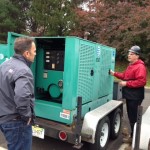Tags
Related Posts
Share This
AT&T Finishes Prepping For Hurricane Sandy!
 AT&T has finished prepping for Hurricane Sandy in New Jersey! They have a large amount of workers and disaster response equipment on standby, this way AT&T will be ready for a quick response. AT&T has gotten a disaster preparedness certification under the Department of Homeland Security Voluntary Private Sector Preparedness Program and they are the first private sector company to get this. Since 1991 $600 million has been invested into AT&T’s Network Disaster Recovery function. This will help to make sure that wire line and wireless communications will work during emergency situations. They have over 320 technology equipment trailers as well as a large supply of workers to aid as well. They will work together with Emergency Operations Centers and Local Response Centers. Throughout the year AT&T has simulations and drills to make sure they are prepared for these types of emergencies situations. They are bringing in and deploying many portable generators in New Jersey. They are coming on flat beds from different areas, to help with the response time and to keep the network running. And of course they are topping off the tanks with gas, to make sure they can run for the full-time. AT&T is also positioning additional emergency response equipment in strategic locations where the hurricane is supposed to make landfall. They have also installed permanent and back up generators at switching sites and critical cell sites. The AT&T Global Network Operations Center in Bedminster, N.J. controls the readiness and response of the network. You can see a photo of the operations center above. AT&T has also prepared a list of tips for consumers and small business which can be seen below. For instance you should keep your wireless phone batteries charged at all time, forward your home number to your wireless number, please look over the tips below. AT&T has done a lot of preparation for Hurricane Sandy, for more information check out the full list of tips below, a gallery, and a press release.
AT&T has finished prepping for Hurricane Sandy in New Jersey! They have a large amount of workers and disaster response equipment on standby, this way AT&T will be ready for a quick response. AT&T has gotten a disaster preparedness certification under the Department of Homeland Security Voluntary Private Sector Preparedness Program and they are the first private sector company to get this. Since 1991 $600 million has been invested into AT&T’s Network Disaster Recovery function. This will help to make sure that wire line and wireless communications will work during emergency situations. They have over 320 technology equipment trailers as well as a large supply of workers to aid as well. They will work together with Emergency Operations Centers and Local Response Centers. Throughout the year AT&T has simulations and drills to make sure they are prepared for these types of emergencies situations. They are bringing in and deploying many portable generators in New Jersey. They are coming on flat beds from different areas, to help with the response time and to keep the network running. And of course they are topping off the tanks with gas, to make sure they can run for the full-time. AT&T is also positioning additional emergency response equipment in strategic locations where the hurricane is supposed to make landfall. They have also installed permanent and back up generators at switching sites and critical cell sites. The AT&T Global Network Operations Center in Bedminster, N.J. controls the readiness and response of the network. You can see a photo of the operations center above. AT&T has also prepared a list of tips for consumers and small business which can be seen below. For instance you should keep your wireless phone batteries charged at all time, forward your home number to your wireless number, please look over the tips below. AT&T has done a lot of preparation for Hurricane Sandy, for more information check out the full list of tips below, a gallery, and a press release.
Gallery
Press Release
AT&T NETWORKS PREPARED AS HURRICANE SANDY APPROACHES NEW JERSEY
Company Encourages Customers to Prepare, Offers Communication Tips
New JERSEY, Oct. 27, 2012 - With an arsenal of disaster response equipment and personnel on standby as Hurricane Sandy nears the Garden State, AT&T* is ready to respond quickly. AT&T is the first private sector company in the nation to receive disaster preparedness certification under the Department of Homeland Security Voluntary Private Sector Preparedness Program.
Since 1991, AT&T has invested more than $600 million in our Network Disaster Recovery function – one of the industry’s largest and most advanced disaster response programs – to help ensure the flow of wireless and wireline communications during emergencies. The NDR arsenal of equipment includes more than 320 technology and equipment trailers that can be quickly deployed to respond to events, such as hurricanes. The Network Disaster Recovery team works closely with local AT&T network personnel, regional Emergency Operations Centers and Local Response Centers to restore and maintain service until permanent repairs can be made.
To help maximize network reliability during a storm, AT&T conducts readiness drills and simulations throughout the year to ensure our networks are prepared and our personnel are ready to respond at a moment’s notice, and our networks are monitored 24/7.
Other preparations include:
* Topping off fuel at generators positioned at cell sites
* Deploying portable generators to staging areas for rapid deployments – we conduct safety and serviceability checks at this time
* Staging additional emergency response equipment in strategic locations in areas outside of the predicted landfall, ready to move in rapidly as the storm passed. This equipment includes additional generators, fuel tankers.
* Place 3rd party vendors and suppliers on standby, retaining their skilled resources for the event. This multiplies the number of support players in region.In addition, AT&T has continued to enhance network redundancy in hurricane-prone areas by installing more back-up and permanent generators at critical cell sites and switching facilities; locating critical equipment to less vulnerable areas; upgrading electronics critical to network operations above expected flood levels; and protecting physical facilities against flooding.
Just as we prepare our networks and personnel, AT&T encourages residents and small businesses to consider the following recommendations in preparation for the storm.
Consumer Tips:
* Keep your wireless phone batteries charged at all times. Have an alternative plan to recharge your battery in case of a power outage, such as using your car charger to charge your device or having extra mobile phone batteries on hand or an independently charged power pack that can charge your phone without electrical power (please note, some phones do not have a battery than can be replaced).
* Keep your wireless phone dry. The biggest threat to your device during a hurricane is water, so keep your equipment safe from the elements by storing it in a baggie or some other type of protective covering.
* Have a family communication plan in place. Designate someone out of the area as a central contact, and make certain that all family members know who to contact if they get separated. Most importantly, practice your emergency plan in advance.
* Program all of your emergency contact numbers and e-mail addresses into your mobile phone. Numbers should include the police department, fire station and hospital, as well as your family members.
* Forward your home number to your wireless number in the event of an evacuation. Because call forwarding is based out of the telephone central office, you will get incoming calls from your landline phone even if your local telephone service is disrupted at your home. In the unlikely event that the central office is not operational, services such as Voicemail, Call Forwarding, Remote Access call forwarding and call forwarding busy line/don’t answer may be useful.
* Track the storm and access weather information on your wireless device. Many homes lose power during severe weather. If you have a wireless device that provides access to the Internet, you can download weather apps, watch weather reports and keep updated with local radar and severe weather alerts.
* Camera phones provide assistance. If you have a camera phone, take, store and send photos – even video clips – of damaged property to your insurance company from your device.
* Take advantage of location-based mapping technology. Services such as AT&T Navigator and AT&T FamilyMap<https://familymap.wireless.att.com/finder-att-family/flashDemo.htm> can help you seek evacuation routes or avoid traffic congestion from downed trees or power lines, as well as track a family member’s wireless device in case you get separated.Small Business Tips:
* Set up a call-forwarding service to a predetermined backup location. Set up a single or multiple hotline number(s) for employees, employees’ families, customers and partners, as appropriate, to call so that all parties know about the business situation and emergency plan. For this to be most effective, maintain an updated contact list, including mobile and home phone numbers and e-mail addresses, for all employees.
* Protect hardware/software/data records/employee records, etc. Routinely back up these files to an off-site location and consider cloud services. Use a generator for supplying backup power to vital computer hardware and other mission-critical equipment. Prearrange the replacement of damaged hardware with vendors to ensure quick business recovery.
* Outline detailed plans for evacuation and shelter-in-place plans. Practice these plans (employee training, etc.). Establish a backup location for your business and meeting place for all employees.
* Assemble a crisis-management team and coordinate efforts with neighboring businesses and building management. Be aware that disasters affecting your suppliers also affect your business. Outline a plan for supply chain continuity for business essentials.
* Consider a back-up cellular network. A microcell acts like a small cell site at a business location.
* Maximizing Service During and After a Hurricane:
* Try text messaging. During an emergency situation, text messages may go through more quickly than voice calls because they require fewer network resources. All of AT&T’s wireless devices are text messaging capable. Depending on your text or data plan, additional charges may apply.
* Be prepared for high call volume. During an emergency, many people are trying to use their phones at the same time. The increased calling volume may create network congestion, leading to “fast busy” signals on your wireless phone or a slow dial tone on your landline phone. If this happens, hang up, wait several seconds and then try the call again. This allows your original call data to clear the network before you try again.
* Keep non-emergency calls to a minimum, and limit your calls to the most important ones. If there is severe weather, chances are many people will be attempting to place calls to loved ones, friends and business associates.Additional information and tips for disaster preparedness can be found atwww.att.com/vitalconnections<http://www.att.com/vitalconnections>.
Copyright NJTechReviews LLC 2010-2012. All Rights Reserved.







